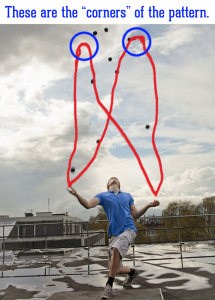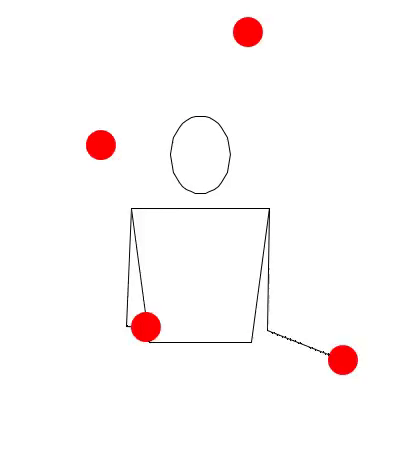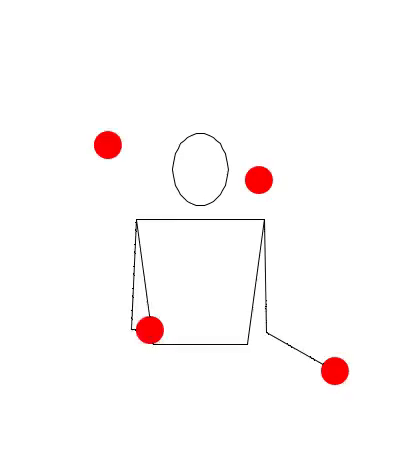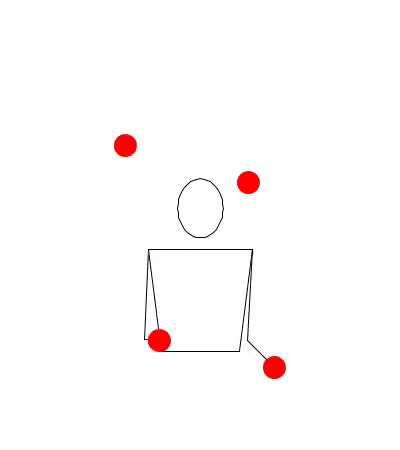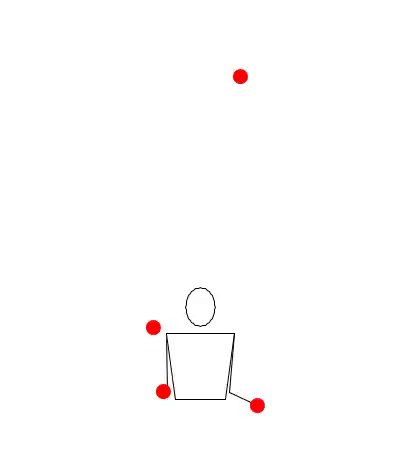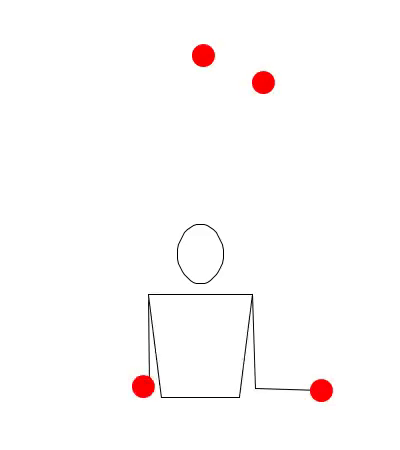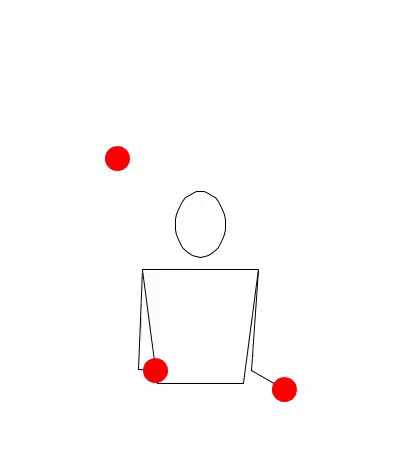Everything you need to know about Five Ball Juggling
Folks often email me with questions like “How do I learn to juggle five balls?” “What kind of balls should I learn five with?” and “Why am I struggling?” This post is a catch-all article that addresses some of these questions.
First and foremost – the best props to use are the ones you’ve got. There’s no silver bullet juggling ball that will make your patterns better. When I first started working on five, I used misprinted Higgins Brothers beanbags. Then I moved on to 4″ Dube stage balls. Then Fergies (remember those?) Then SportCo beanbags. Then russians. Then back to beanbags. And so on and so forth. None of those props made my patterns any cleaner – that’s something that only practice can do for you.
That said, though, if you’ve got money burning in your pocket and you’re set on buying a special set of props, I’d strongly suggest you use that as a reward. Can you qualify five consistently? Why not treat yourself to those balls after you’ve gotten 50 catches? Not there yet? How about buying that set after you get 20 cycles of all of your four ball drills in a single practice session? It might sound cliche, but rewarding a milestone with a nicer set of props will really change the way you approach practicing.
If you’re looking for prop recommendations, I have some recommendations over here.
Vocabulary
A flash of a pattern is n catches, where n is also equal to the number of objects thrown. So, in the context of five ball juggling, it means five balls thrown then caught. Depending on the context, some people refer to this as one side of a pattern.
The word flash can also mean making the throws higher for a designated number of throws, so you can do a pirouette underneath the pattern. Don’t worry about this for now, though.
A qualify is twice as many catches as a flash, or n*2. Speaking about five balls, this would mean ten catches of a cascade pattern.
The corner of your pattern is where the ball peaks at the top of its arc. When I talk about “placing” a throw, I mean a throw that intentionally peaks right in this spot. It’s nice to think about delicately placing a ball there, rather than chucking in the general area.
“Hey, Thom!” you shout, “This diagram sucks! Besides that – what’s the difference between a “corner” and the “peak” of a throw?”
I’m glad you asked. I’m a failed graphic design minor. So yeah, maybe it’s a little off. The general idea, though, is that the corner refers to the two-dimensional picture plane in front of you. The corner is an absolute point, over the vertical line of your shoulder. The difference between “corner” and “peak” is just that – we’re talking about corners because it’s an absolute. Every throw has its own peak, thanks to gravity. Not every throw reaches the corner of your pattern – That’s where practice and precision comes in.
The crossing point is where the trajectories of throws in an odd-numbered pattern (3, 5, 7, etc.) intersect. A low crossing point results in a wider pattern. A high crossing point results in a slimmer pattern.
Siteswap Notation is a system for writing down juggling patterns, measuring how long it takes an object to return to a hand after it has been thrown. (Some people use a shorthand and say that it’s the throw height. Technically that’s wrong, but feel free to interchange height and time in this article. (Just know that it’s wrong for now.))
If you don’t have a good grasp on siteswap, now would be a good time to bone up on it. This article will get pretty siteswap heavy in a moment. Above is a wonderful tutorial video that Mike Moore made on behalf of the International Juggler’s Association a while back.
If you’d prefer to read about siteswap, I wrote a blog post over here that explains it.
A yurt, according to Urban Dictionary, is …a round tent, supported by wood lattice on the sides, with a smoke exit hole on top and made of cloth, leather or felt. Home to Mongolians and Californian hippies (but not together.)
Starting Grips
When you start juggling with five balls, you hold three in one hand, and two in the other. Starting a pattern with three in one hand can be a tricky thing when you first start. Let’s clear up how to properly hold three balls in one hand.
NO.
This is not the way to start. What are you doing.
NO.
This is also not the way to start.
(Fun fact: In Australia, some people call this the “NICA Grip” because it’s the way that an American juggling student insisted on starting it when he studied there. It was never advocated as the proper start by anyone at the school, other than that one guy. Not naming names, but don’t be like him.)
YES.
A triangle, with one held by the pinky and ring fingers, one held by the middle and index fingers, and one between the thumb and the palm.
The thumb ball is released first, then the index, then the pinky.
Easy!
Let’s get Serious
Enough with the little details – Let’s get to work. You’re probably wondering what I meant when I talked about four balls drills earlier on.
Here’s the thing (we’re about to get a little cosmic here, guys… step into my yurt and let’s light some incense, alright?) The five ball cascade is really a representation of your mastery of four balls. It’s a representation of your overall juggling technique. It’s not a one-off trick, it’s a way of showing that you’ve put in some time and have a solid understanding of how juggling works.
A clean pattern happens because of a number of different factors. In order to run it smoothly, you need to have proficiency with accurate placement, an appropriate tempo, and a 5 height that’s proportional to all of the other throw heights your body has learned (that’s the siteswap 5 – if you’re not familiar with the topic, watch this video before moving on!) With a consistent three ball cascade (siteswap: 3) – or better yet, a consistent four ball fountain (siteswap: 4), you’ve got all of the tools you need to learn what a 5 looks like. That is, you’ll know the exact height a 5 needs to be so that you don’t have funny shifts in tempo or placement that cause you to correct.
A 5 that’s too low effectively speeds up time – that’ll make you rely on handspeed to continue with the pattern (and that’s a bad thing. If you want to progress, you need to grow technique that’s founded on tall, beautiful throws. Relying on handspeed means to be reactionary – you want to control the pattern, not have the pattern control you.)
“Okay,” you say, “I’m going to leave this yurt unless you start giving me practical tips.” Fair enough. Let’s get to it.
A throw is like a vocabulary word. Learn to pronouce it well, then put it into a sentence. (“You had your warning, Thom. I’m leaving now!” “No, hold up! This will all come to a head in a second!”) If our goal is to get a perfect five, let’s work on some patterns that force you to attend to the 5 as it relates to throws you already know. Simple geometry. (“You’re mixing metaphors. I’m leaving.”)
Some of the best patterns to work on for the juggler who’s about ready to flash five balls:
5551
55514
534
7441
71
51
531
You’ll notice that I left a few “standard” training patterns out of this list – notably the snake (Siteswap: 50505), the three ball flash (Siteswap: 55500), and 522. That’s because those patterns all have 0s and 2s in them. If we’re working on these patterns as a way to measure a 5 against other throws you already know, the method totally falls apart. How long does it take you to not throw a ball (Siteswap: 0), or to hold a ball in your hand (Siteswap: 2)? That’s a hard question to answer, isn’t it? (Maybe a Buddhist monk would know the answer. Want to climb a mountain with me later?)
Of the patterns I recommend, 5551 and 55514 are king. 5551 – especially training it into and out of a four ball fountain (that is 44444…. 5551 44444….) forces you to notice the relationship between the 5 and the 4 immediately next to one another. If you’re throwing the 5s too high or too low, your tempo will be off when you re-enter the fountain. Drill this until it’s starting to feel more comfortable (on both sides!), then start working on repeating the pattern (so, 44444…. 55515551 4444…) and then start working on getting the pattern to switch sides with a single 4 (that’s 55514 – so, 4444… 555145551 4444…) Rinse, repeat, level up.
I suggest the three ball shower in both directions (Siteswap 51) as a way to focus on the way your hand throws the 5. Are you doing a proper hand scoop, or are you catapaulting the ball? Drill this, learn to switch sides (Siteswap 51251) and see how it goes.
531 with the 1 behind the back is a way to really be honest about getting your throw heights solid. There’s no way to cheat this one with handspeed, as your arms will be momentarily behind your back. It’ll only work if the throws are nice and tall.
7441 is a great way to cross train a bit – If a 5 is a certain height, what’s a 7? Really, just a super tall 5, right? If you’re working on these drills, you likely have a solid 441 with three. It can be helpful for some learners to learn what their natural 5 is by approaching it from the other direction – learn what a 5 isn’t, as well.
These drills aren’t put in any particular order – some will be more challenging than others. Focus on one for a while, then start working on another. Working on a variety of these patterns at the same time will help keep you sane – and will make you a more proficient juggler, to boot. Not a bad deal at all.
(These drills all have parallels with Richard Kennison’s methodology when coaching juggling. If you’re looking for a great juggling coach and you’re in Philadelphia, you should definitely look him up.)
Preparing for your first Five Ball Flash
When you decide it’s time to go for your first five ball flash, here’s your mantra: Place three, chuck two. You’ve got a lot of stuff to get out of your hands, so it’s tempting to rush it. To counter this, think about placing the first three balls slowly into the corners of the pattern, then rush the last two (but ONLY if you feel like you NEED to rush!) We’re getting into the habit of a tall, slow pattern. Accuracy and height over hand-speed! Remember – if you have a solid 5551, you’ve already got a solid 555. A five ball flash is just five 5s in a row, and you’re already nailing the first three! Remember your tempo from the four ball drills, place those first three 5s into their spot in the air, and if you’ve got to rush, only rush the last two. As always, height is your friend.
If you’re already getting 10-20 catches with some regularity, here are some of my favorite drills:
• Clean five ball flashes starting on each side (yep, you’ve got to learn to release three from your left hand, too! If you don’t, how will you ever learn a six fountain?)
• Isolation training. When I was teaching Chloe how to juggle, she’d call this “juggle island” (and, I’ll add, she hated it. Because this drill can really suck.) Work on your five flashes and longer runs while standing on a chair. (Work on the four ball drills this way, too!) Isolating your body in space will make you realize how much you’re relying on corrections, rather than perfect throws. It’s sobering, but don’t beat yourself up about it if you find it frustrating!
Jason Garfield of the World Juggling Federation really preaches this method, and gets a lot of credit for being “his thing.” The idea of isolating body movement has been around for a while, but he certainly brought the technique in vogue with modern jugglers.
• If you’re still in the 10-20 catch club, don’t forget to work on your four ball drills. When you practice those drills, you’re also practicing five. (Remember what we said back in the yurt? All that stuff about learning proportional throws, beautiful rhythms and placements? Still applies.)
Can I skip from three to five without all of this four nonsense?
NO.
Onwards and Upwards
If you’re already in the 50-catch club, it’s time to start drilling the harder stuff.
Five ball tennis is a personal favorite – That is, one ball thrown back and forth over the pattern as a reverse cascade throw. This is one of the drills that Richard Kennison, the juggling coach and IJA Educational Excellence award winner I mentioned early, preaches in his workshops. This drill forces you to attend to the reverse 5, leaving your lizard brain (or muscle memory, or whatever you want to call it) to make the 5s that happen underneath it. This is a great drill to see how consistent your 5s really are. In the educational world, they’d describe this as a way to see if your explicit knowledge has gelled into implicit knowledge. To see if you’ve gotten to a level where your body does the action (here, the 5s under the reverse throw) without direct, conscious input.
Endurance. Your goal is a five minute long run (that’s roughly 1,250 catches.) To build up to this level, you’re going to have to build a little body muscle and a little brain muscle. Set a timer to five minutes and start running your five cascade. If you drop, pick up and keep going. Focus on clean throws that are placed where they should be. If you’re feeling particularly motivated, do this drill at the start and end of every practice session.
Once you finally get a run of 2+ minutes, start working on this in isolation, with a balance, with a headbounce, or anything else you can think of to add difficulty. When I started training endurance more diligently, I brought my personal best from 2 minutes to 20 minutes in about a month and a half. (“Will you juggle five balls for me for 20 minutes at the next festival I go to, Thom?” “Absolutely not. I was young and foolish back then. Much easier to tell you to do it, instead.”)
Notes and Caveats
Of course, these tips aren’t the only way to train. Give them all a shot, and see what works for you! If you find the three snake (that’s 50505) to work well, absolutely pursue it. The key to progress is pushing yourself and putting the hours in. Everyone’s internal syllabus is different (but I will mention that I coached someone from zero juggling experience at all to 50 catches of five within six weeks using this method. She was super motivated, though, and the idea of proportional throws really jived with her learning style. Your mileage may (read: very likely will) vary.)
One training method I didn’t mention is the pyramid technique. I’ve never found it to work for me, but Warren Hammond (another IJA Educational Excellence award winner!) swears by it. No one method will work for everyone – the pyramid technique might be the key for you if some of the other drills we talked about didn’t jibe.
Essentially, the pyramid technique is a sneaky way to get you warmed up with clean starts and finishes, slowly increasing the number of throws in each run. Here’s an example of a pyramid-style training session:
Five ball flash: 20x clean. (Expert mode: alternating starting hands between each attempt.)
Seven catches: 15x clean.
Five ball qualify: 10x clean.
Twenty catches: 5x clean.
Fifty catches: 3x clean.
By the end of this particular example, you will have done 55 clean starts and finishes in a training session. If you’re motivated by having a real, concrete way to track your progress, this might be a method you’d have success with.
Another tip that you might find helpful is learning to balance. I’ll save some of that information for a later post, but balancing a dowel / club / shovel / whatever you’ve got around the house will train your body to understand its center line. That is, coincidentally, the same line where the balls cross in front of your body. Training this isn’t exactly toss juggling, but your arms will need a break sometime (especially after you’ve done your endurance drills, right?) This is an extremely good skill that will serve you well as you progress with your juggling in the future.
I’ve got a lot more to say about balance, but that’s pretty tangential to a conversation about five balls. We’ll save that for a blog post somewhere down the line.
…and that’s all I’ve got to say about that.
If you’ve got thoughts on any of this, feel free to drop me an email or comment below. If you’re on Reddit already, why not join us over at /r/juggling , too? There’s a veritable army of people there who are ready and willing to give you tips if you post a training video.


